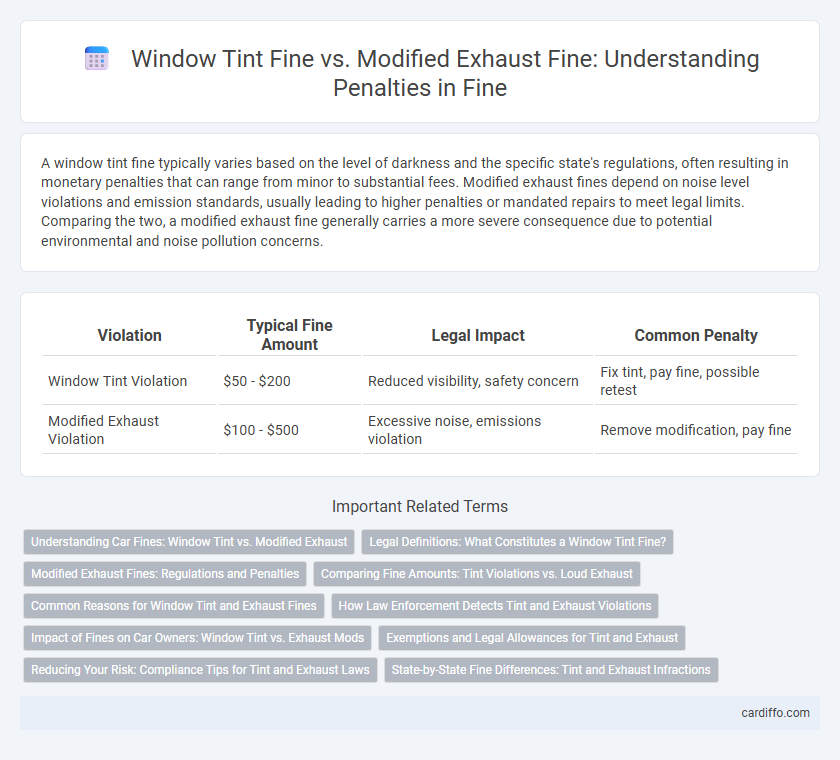A window tint fine typically varies based on the level of darkness and the specific state's regulations, often resulting in monetary penalties that can range from minor to substantial fees. Modified exhaust fines depend on noise level violations and emission standards, usually leading to higher penalties or mandated repairs to meet legal limits. Comparing the two, a modified exhaust fine generally carries a more severe consequence due to potential environmental and noise pollution concerns.
Table of Comparison
| Violation | Typical Fine Amount | Legal Impact | Common Penalty |
|---|---|---|---|
| Window Tint Violation | $50 - $200 | Reduced visibility, safety concern | Fix tint, pay fine, possible retest |
| Modified Exhaust Violation | $100 - $500 | Excessive noise, emissions violation | Remove modification, pay fine |
Understanding Car Fines: Window Tint vs. Modified Exhaust
Car fines for window tint violations often depend on the percentage of light allowed to pass through, with many states enforcing limits between 30% and 50% VLT (Visible Light Transmission). Modified exhaust fines vary based on noise level regulations, which usually cap sound emissions around 95 decibels to reduce noise pollution. Understanding the specific legal thresholds for window tint darkness and exhaust noise in your area is crucial to avoid costly penalties and ensure compliance with state vehicle codes.
Legal Definitions: What Constitutes a Window Tint Fine?
A window tint fine occurs when a vehicle's window film exceeds the legally allowed light transmittance percentage, typically below 70% visible light transmission (VLT) on front side windows in many states. Law enforcement measures the tint darkness using a photometer to ensure compliance with state-specific regulations defined in vehicle code statutes. Contrastingly, a modified exhaust fine results from alterations that violate noise level limits or emission standards set by environmental and traffic authorities.
Modified Exhaust Fines: Regulations and Penalties
Modified exhaust fines vary significantly depending on jurisdiction, often imposed to curb noise pollution and environmental impact. Penalties may include steep monetary fines ranging from $100 to over $1,000, vehicle impoundment, or mandatory exhaust system restoration to meet legal standards. Strict enforcement typically targets excessive decibel levels and unauthorized alterations that violate local noise ordinances and emissions regulations.
Comparing Fine Amounts: Tint Violations vs. Loud Exhaust
Fines for window tint violations typically range from $50 to $200, depending on state regulations and the degree of tint darkness. Modified exhaust fines are often higher, spanning $100 to $500, as excessive noise levels can pose broader public disturbances and safety concerns. Enforcement agencies prioritize louder exhaust penalties due to their impact on noise pollution, making these fines more stringent compared to standard tint infractions.
Common Reasons for Window Tint and Exhaust Fines
Common reasons for window tint fines include tint darkness exceeding legal limits, non-compliant film materials, and improper installation blocking driver visibility. Exhaust fines typically arise from modified mufflers causing noise pollution beyond permissible decibel levels and unauthorized emission alterations violating environmental regulations. Both fines serve to ensure safety, noise control, and adherence to vehicle standards set by traffic authorities.
How Law Enforcement Detects Tint and Exhaust Violations
Law enforcement detects window tint violations using specialized light meters that measure the Visible Light Transmission (VLT) percentage through car windows, ensuring compliance with state-specific tint limits. For modified exhaust systems, officers rely on sound level meters to measure decibel output and inspect the exhaust for alterations that exceed legal noise thresholds or lack proper emissions controls. Both methods involve on-site tools and visual inspections to enforce regulations and issue fines for non-compliant vehicles.
Impact of Fines on Car Owners: Window Tint vs. Exhaust Mods
Window tint fines often lead to immediate financial penalties and may require removal of the tint, affecting vehicle aesthetics and privacy. Modified exhaust fines typically stem from noise or emission violations, potentially resulting in costly repairs or revert modifications to meet regulations. Both fines impact car owners financially but modified exhaust penalties often involve more complex compliance and potential vehicle performance changes.
Exemptions and Legal Allowances for Tint and Exhaust
Window tint regulations often include specific exemptions for medical conditions requiring reduced glare, while modified exhaust systems typically face stricter noise and emission standards with limited exemptions. Legal allowances for window tint vary by state, frequently permitting a certain percentage of visible light transmission, whereas exhaust modifications must comply with local noise ordinances and emission control laws to avoid fines. Understanding these exemptions ensures compliance and minimizes penalties for both window tinting and exhaust modifications.
Reducing Your Risk: Compliance Tips for Tint and Exhaust Laws
Reducing your risk of fines for non-compliant window tint or modified exhaust requires understanding specific state regulations, such as visible light transmission (VLT) percentages and noise level limits. Ensuring your window tint adheres to local VLT limits, typically ranging from 20% to 50%, and verifying that your exhaust system meets decibel restrictions can prevent costly citations. Regular inspections and using certified installers help maintain compliance and avoid penalties related to tint darkness or excessive exhaust noise.
State-by-State Fine Differences: Tint and Exhaust Infractions
Window tint fines and modified exhaust fines vary significantly across states due to differing regulations on allowable tint percentages and decibel limits for noise pollution, with some states imposing fines exceeding $500 for violations. For example, California enforces strict window tint laws with fines up to $200, while its modified exhaust penalties can reach $1,000 for non-compliant mufflers. Conversely, states like Texas have more lenient tint restrictions but impose hefty fines on excessive exhaust noise, reflecting diverse enforcement priorities nationwide.
window tint fine vs modified exhaust fine Infographic

 cardiffo.com
cardiffo.com